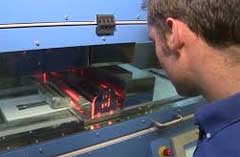3D printing, also known as additive manufacturing, has certainly received its share of hype in recent years, both on its own and as one of the most prominent "digital technologies" that companies can embrace.
Supply Chain Digest Says... |
|
|
In fact, we recently summarize a report on the web site of MAPI – The Manufacturing Alliance, which argued that advances in 3D printing, combined with "digital distribution" (think Amazon's network) will transform the US manufacturing landscape and revitalize parts of the Rust Belt. (See Here Comes the Internet of Goods Part 2.)
But there are limitations for sure, including the range of materials that can be used and more importantly the high cost per piece, which has limited 3D printing use to prototyping or application in making parts of various kinds, where relatively few items are needed and 3D printing can eliminate costly inventories of slow moving SKUs
This week, the magazine DesignNews summarized a recent webinar featuring Dayton Horvath, a principal at investment firm NewCap Partners, and who has some keen insights into where things really stand with 3D printing.
Horvath told DesignNews there is major progress in three areas: materials, software, and printing hardware.
In materials, Horvath said there are now printable higher performance thermoplastics and new metal alloys that are printable, extending the range of products that can be printed.
In software, Horvath says there are modeling and simulation tools that when combined with "generative design" enable engineers to create designs specifically for additive manufacturing while taking into account process simulation.
With regard to 3D printers, Horvath says prices continue to fall, allowing many contract manufacturers and job shops to afford the technology for the first time.
(See More Below)
But as noted above, limitations remain. A key one is that additive manufacturing is not nearly as consistent as traditional manufacturing approaches.
 "Additive manufacturing is still part art and part science," Horvath told DesigNews. "It is not repeatable and consistent to the extent manufacturers are used to in subtractive manufacturing or with injection molding technologies. As a result, we still have a long way to go in developing end-use application workflows that offer reproducible results that contract manufacturers and job shops can bank on going forward." "Additive manufacturing is still part art and part science," Horvath told DesigNews. "It is not repeatable and consistent to the extent manufacturers are used to in subtractive manufacturing or with injection molding technologies. As a result, we still have a long way to go in developing end-use application workflows that offer reproducible results that contract manufacturers and job shops can bank on going forward."
A lack of engineers who can design for 3D printing is another obstacle. Horvath also said that while costs have come down, it does take investment to get into 3D printing, a barrier for many firms.
Horvath says 3D printing is clearly ready for prime time for prototype development. In fact, he says companies not yet using the technology for product development and functional prototyping are behind the adoption curve.
Horvath also says 3D printing is ready for production of tooling, molds, and fixtures, though a minority of manufacturers have been using the technology for these applications.
But it's a different case for production parts. Here, 3D printing is still not ready, Horvath says, though it could be in three years or so. By then, new 3D printing technologies will be commercially available and tested.
What about for distributed manufacturing, of the type the MAPI report expects? Not likely until 2025, Horvath predicts. The supply chain advantages of 3D printing are difficult to quantify and how you implement a decentralized business model is not close to clear at this time, he adds.
Any reaction to this take on the state of 3D manufacturing? Is the take took conservative, too aggressive, or just about right? Let us know your thoughts at the Feedback section below.
Your Comments/Feedback
|